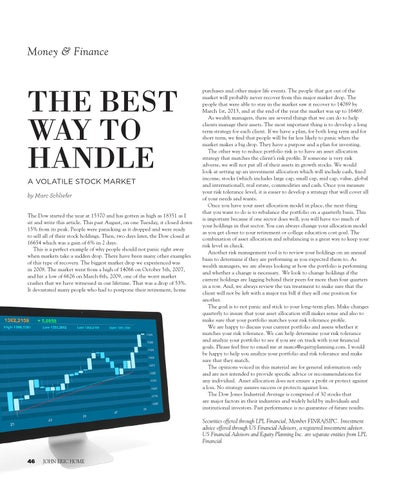Money & Finance
THE BEST WAY TO HANDLE A VOLATILE STOCK MARKET by Marc Schliefer The Dow started the year at 15370 and has gotten as high as 18351 as I sit and write this article. This past August, on one Tuesday, it closed down 15% from its peak. People were panicking as it dropped and were ready to sell all of their stock holdings. Then, two days later, the Dow closed at 16654 which was a gain of 6% in 2 days. This is a perfect example of why people should not panic right away when markets take a sudden drop. There have been many other examples of this type of recovery. The biggest market drop we experienced was in 2008. The market went from a high of 14066 on October 5th, 2007, and hit a low of 6626 on March 6th, 2009, one of the worst market crashes that we have witnessed in our lifetime. That was a drop of 53%. It devastated many people who had to postpone their retirement, home
purchases and other major life events. The people that got out of the market will probably never recover from this major market drop. The people that were able to stay in the market saw it recover to 14089 by March 1st, 2013, and at the end of the year the market was up to 16469. As wealth managers, there are several things that we can do to help clients manage their assets. The most important thing is to develop a long term strategy for each client. If we have a plan, for both long term and for short term, we find that people will be far less likely to panic when the market makes a big drop. They have a purpose and a plan for investing. The other way to reduce portfolio risk is to have an asset allocation strategy that matches the client’s risk profile. If someone is very risk adverse, we will not put all of their assets in growth stocks. We would look at setting up an investment allocation which will include cash, fixed income, stocks (which includes large cap, small cap, mid cap, value, global and international), real estate, commodities and cash. Once you measure your risk tolerance level, it is easier to develop a strategy that will cover all of your needs and wants. Once you have your asset allocation model in place, the next thing that you want to do is to rebalance the portfolio on a quarterly basis. This is important because if one sector does well, you will have too much of your holdings in that sector. You can always change your allocation model as you get closer to your retirement or college education cost goal. The combination of asset allocation and rebalancing is a great way to keep your risk level in check. Another risk management tool is to review your holdings on an annual basis to determine if they are performing as you expected them to. As wealth managers, we are always looking at how the portfolio is performing and whether a change is necessary. We look to change holdings if the current holdings are lagging behind their peers for more than four quarters in a row. And, we always review the tax treatment to make sure that the client will not be left with a major tax bill if they sell one position for another. The goal is to not panic and stick to your long-term plan. Make changes quarterly to insure that your asset allocation still makes sense and also to make sure that your portfolio matches your risk tolerance profile. We are happy to discuss your current portfolio and assess whether it matches your risk tolerance. We can help determine your risk tolerance and analyze your portfolio to see if you are on track with your financial goals. Please feel free to email me at marcs@equityplanning.com. I would be happy to help you analyze your portfolio and risk tolerance and make sure that they match. The opinions voiced in this material are for general information only and are not intended to provide specific advice or recommendations for any individual. Asset allocation does not ensure a profit or protect against a loss. No strategy assures success or protects against loss. The Dow Jones Industrial Average is comprised of 30 stocks that are major factors in their industries and widely held by individuals and institutional investors. Past performance is no guarantee of future results. Securities offered through LPL Financial, Member FINRA/SIPC. Investment advice offered through US Financial Advisors, a registered investment advisor. US Financial Advisors and Equity Planning Inc. are separate entities from LPL Financial
46
JOHN ERIC HOME
